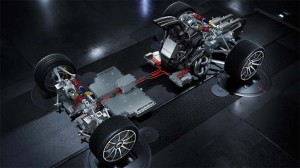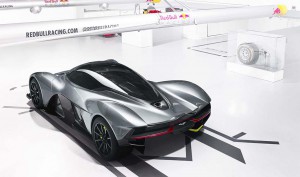When AMG said it was going to uncover its new Project One hypercar at the 24-hour race at Nurburgring over the weekend, it wasn’t kidding.
The Mercedes-Benz performance arm rolled out the platform for the 1,020-horsepower monster, sans body. But it offered a good look at how AMG plans to take Formula One technology from track to street, a move that will not only deliver neck-snapping performance but also give Project One owners bragging rights for operating the cleanest hypercar on the road.
“We are the first to make pure bred F1 technology roadworthy,” said AMG Chairman Tobias Moers, during the Project One preview, adding that the hypercar “shifts up the boundaries of what is technically feasible.”
(Mercedes rides the SUV boom with new AMG offerings. Click Here for more.)
Ferrari previously turned to F1 technology for the mid-1990s F50, but track tech has evolved radically since then. AMG is one of at least three manufacturers racing to put modern Formula One technology into everyday application – the others being Aston Martin and Infiniti. But it’s the first to offer a close-up look at how it will pull off that challenging task.
Project One is not a direct lift. It’s not an F1 powertrain in a street-legal body, though it does rely on an incredibly compact 1.6-liter turbocharged V-6 engine. The track KERS – or Kinetic Energy Recovery System – is here modified into a plug-in hybrid system using four electric motors, one for each front wheel, another driving the crankshaft and the fourth powering the internal combustion engine’s turbo.
“Plug-in hybrid is going to be the future for AMG. We get more performance and more efficiency and what’s wrong with that?” asked Moers.
The system will be able to deliver up to 15 miles in pure electric mode. That will not only give owners some green creds but allow them access to a number of cities that are either planning to bar conventional gas engines or, in the case of London, impose hefty access fees.
The basic technology is, indeed, based on the F1 KERS system, Moers noted, but the lithium-ion battery pack on the two-seater has about four times more storage capacity.
The 748-hp 1.6-liter engine may wind up as the most efficient gasoline package ever to hit the road, AMG claiming its thermal efficiency tops out at 43%, or better than current diesels and in the range of what some of the best gas-electric hybrids can manage. The tiny V-6, meanwhile, will redline at 11,000 RPM. And it should experience zero turbolag since it relies on an electric motor for its boost, rather than an exhaust gas-driven turbine.
The V-6 will be paired with an F1-derived manual transmission using a computer-controlled clutch. One of the more interesting strategies will be to use the electric motors – which give the vehicle all-wheel-drive – to maintain torque during shifts.
(Aston Martin promises more than 1,000 hp from its F1-based hypercar. Click Here for more.)
AMG isn’t revealing any performance numbers but considering the brand’s far less exotic GT can handily hit 60 in less than four seconds, speculation centers around a number likely to dip to three seconds – or less — with the new hypercar. That said, AMG development director Philipp Eckert told reporters the Daimler division is not aiming for the fastest launch times on the road. That probably makes sense, as a wave of new battery-electric cars, such as the upcoming Faraday Future FF1 and Lucid Air models are targeting bragging rights in that column.
To scrub off speed, the new two-seater will opt for carbon ceramic brakes, with wheel-mounted fins helping to keep them cool.
The suspension will go five-link front and after, and there will be two springs per corner, each paired with a single damper. The electronically controlled system will allow for variable ride height, the car hunkering down as low as possible at higher speeds to improve aero.
Visually, the Project One car is expected to be a stunner, albeit looking more like something you might expect on the Le Mans circuit. Among the details AMG has revealed, it will feature gull-wing doors, much like the brand’s first supercar developed in-house, the SLS.
Aerodynamics and lightweighting are critical parts of the project and preliminary reporters indicate the production version should weigh in at less than 2,900 pounds thanks to the extensive use of carbon fiber.
Plans call for Project One development to be completed by late next year. AMG says it plans to produce just 275 of the hypercars, rolling them all out by 2020, with pricing expected to come in at about $2.54 million apiece. But those expecting to put any miles on the car had better set aside a significant chunk of cash to keep it running. While AMG officials stressed that they have taken steps to improve the durability of F1 hardware, they also noted that their new hypercar will need a complete engine rebuild after about 30,000 miles.
(Infiniti taking F1 to the street with Project Black S. Click Here to learn more.)




